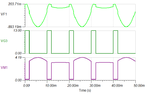T
treez
Guest
Hello,
We are using a TS391ILT open collector comparator.
Its Vdd is 14V
Its output has a 33k pullup to 3V3, and the output goes to a microcontroller input. This microcontroller is supplied by the same 3V3 that the output pulls up to.
On the noninverting input pin we have an 8V3 reference voltage.
On the inverting input pin we have a square wave which has a frequency of 10ms and goes from zero volts to 13V.
At the output of the comparator, when the output should be pulled up to 3V3…it is instead pulling up to about 3.9V.
Do you think this is due to leakage current from the Vdd pin to the output pin?
Why does the datasheet not mention it?
How high would you expect this leakage current to go with ambient temperature rise to say 85degC?
TS391 datasheet....
https://www.st.com/content/ccc/reso...df/jcr:content/translations/en.CD00001660.pdf
We are using a TS391ILT open collector comparator.
Its Vdd is 14V
Its output has a 33k pullup to 3V3, and the output goes to a microcontroller input. This microcontroller is supplied by the same 3V3 that the output pulls up to.
On the noninverting input pin we have an 8V3 reference voltage.
On the inverting input pin we have a square wave which has a frequency of 10ms and goes from zero volts to 13V.
At the output of the comparator, when the output should be pulled up to 3V3…it is instead pulling up to about 3.9V.
Do you think this is due to leakage current from the Vdd pin to the output pin?
Why does the datasheet not mention it?
How high would you expect this leakage current to go with ambient temperature rise to say 85degC?
TS391 datasheet....
https://www.st.com/content/ccc/reso...df/jcr:content/translations/en.CD00001660.pdf


